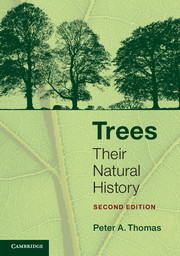Book contents
- Frontmatter
- Epigraph
- Contents
- Preface
- Chapter 1 An overview
- Chapter 2 Leaves: the food producers
- Chapter 3 The trunk and branches: more than a connecting drainpipe
- Chapter 4 Roots: the hidden tree
- Chapter 5 Towards the next generation: flowers, fruits and seeds
- Chapter 6 The growing tree
- Chapter 7 The shape of trees
- Chapter 8 The next generation: new trees from old
- Chapter 9 Age, health, damage and death: living in a hostile world
- Chapter 10 Trees and us
- Further Reading
- Index
- References
Chapter 6 - The growing tree
Published online by Cambridge University Press: 05 July 2014
- Frontmatter
- Epigraph
- Contents
- Preface
- Chapter 1 An overview
- Chapter 2 Leaves: the food producers
- Chapter 3 The trunk and branches: more than a connecting drainpipe
- Chapter 4 Roots: the hidden tree
- Chapter 5 Towards the next generation: flowers, fruits and seeds
- Chapter 6 The growing tree
- Chapter 7 The shape of trees
- Chapter 8 The next generation: new trees from old
- Chapter 9 Age, health, damage and death: living in a hostile world
- Chapter 10 Trees and us
- Further Reading
- Index
- References
Summary
The growth of trees leads to greater changes in size than in any other organism: for example, the mass of a giant sequoia (Sequoiadendron giganteum) can increase by 12 orders of magnitude from seed to mature tree (that’s a billion, billion times bigger, equivalent to an average seed of 0.005 grams becoming a tree of 5000 tonnes, which is the right order of magnitude; see below). Not surprisingly, common questions to ask are ‘how quickly will my tree grow?’ and ‘how big will my tree eventually get?’. In this chapter we will look at these and related questions, and the reasons behind the answers.
Speed of growth
Height
You have probably seen films where the hero in the Orient is strapped over a bed of growing bamboo as a means of torture and eventual death, speared by the hard growing shoots. The reason this works is the extraordinarily fast growth of over half a metre per day. While tropical vines and lianas can grow almost as fast, trees proper can’t equal this rate but can nevertheless be impressively quick, especially when young. A number of tropical species can add 8–9 m to their height in a year. A New World relative of the elm, Trema micrantha, has been seen to grow 30 m in 8 years (an average of 3.75 m per year) and a eucalypt (Eucalyptus deglypta) in New Guinea reached 10.6 m in just 15 months. The Guinness Book of Records has in the past quoted the air-speed record for a tree as a specimen of Albizia falcata (now called Paraserianthes falcataria) planted in Malaysia which grew 10.74 m (35 ft 3 in) in 13 months! As you would expect, there is a lot of variation among species. Trees that invade gaps in tropical forests, and need to grow quickly to win the race to the top, grow faster (an average of 1.5–4.0 m in height per year) than later species that can afford to slowly plod upwards through the shade at 0.5–1.2 m per year.
- Type
- Chapter
- Information
- TreesTheir Natural History, pp. 205 - 244Publisher: Cambridge University PressPrint publication year: 2014

